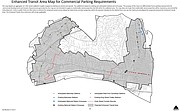“In terms of commercial uses, the way people are getting around has changed.” — Katye North, Principal Planner, Transportation and Environmental Services
Document
(Click on "Download .JPG" to view) Enhanced Transit Area Map for Commercial Parking Requirements
Alexandria has changed since the 1960s. Its parking standards have not. For years, commercial businesses filing for permits in Alexandria have requested and mostly received reductions for parking. Now, at the Planning Commission meeting on Jan. 4, a new set of parking standards for commercial properties will be proposed. If approved, the Right-Sizing Commercial Parking Standards will go before City Council at a public hearing on Jan. 20 for approval.
“In ‘60s, Metro, Dash, and Bikeshare weren’t options,” said Katye North, principal planner for Transportation and Environmental Services. “In terms of commercial uses, the way people are getting around has changed. Thinking about retail; people buy things online. There’s been a bigger push for neighborhood-serving restaurants. For hotels, people usually Uber rather than renting a car and parking it [on-site].”
North says one of the biggest new features of Right-Sizing Commercial Parking Standards is the new Enhanced Transit Area Map. Currently the zoning parking district map breaks the city down into six districts of parking requirements, but the new parking standards simplify the map to two areas: those that are within a half-mile radius of enhanced transit options and those that aren’t. Enhanced transit options in the new parking standards are listed as existing and future Metro stations, transitway routes, and King Street Trolley stops. Areas outside of the enhanced transit zones will require greater parking than those inside the zones.
The right-sized Commercial Parking Standards were preceded by a study that found that 10 percent of the surface area in Alexandria is covered with parking space, and that much of it is underutilized. The study of 60 commercial sites across Alexandria found that during peak usage, 39 percent of the spaces were unused. At some sites, like Canal Center, peak occupancy was as low as 25 percent.
Christopher Ziemann, division chief for Transportation and Environmental Services, also noted that one of the biggest changes in the new parking standards is a parking exemption for small businesses.
“One of biggest changes as we became a lot more aware of the impact of the parking requirements adopted in the ‘60s, [was] the burden on small businesses,” said Ziemann.
Many small businesses in Alexandria move into spaces that were originally built without a requirement for retail or restaurant type parking. These small businesses are often required to try and find access to parking somewhere off-site. During one of the City Council discussions on parking standards, Vice Mayor Justin Wilson referenced a joke in Del Ray that all of the new businesses claimed the same parking spot behind a bank as their off-site parking. Under the new parking standards, any non-residential uses that have a minimum parking requirement of two spaces or less could be exempt from providing parking. This is similar to exemptions granted in Baltimore and Annapolis. Under the proposed minimum parking requirements, this exemption would apply to restaurants with less than 2,000 square feet, retail and office uses in the Enhanced Transit Area with less than 8,000 square feet, and retail and office uses outside the Enhanced Transit Area with less than 2,667 square feet.
“This might encourage some of the new developments to create spaces for small businesses,” said North. “It might encourage existing buildings to turn over into something more active for the rest of the neighborhood.”
One of the last big additions of the new Right-Sizing Commercial Parking Standards is the implementation of a shared parking policy to facilitate and encourage multiple commercial properties to collaborate in providing parking. Currently, the Zoning Ordinance only allows shared parking through an administrative special use permit for uses that are not open at the same time. Due to the requirement that no portion of the hours of operation can overlap, the report says very few businesses are able to take advantage of this provision. Rather than no overlap in hours of operation, the new parking standards allow for shared parking based on times of peak parking usage.
The new parking policy would immediately go into effect if approved by City Council. Monitoring and evaluation of the new standards would continue over five to 10 years to assess how the standards meet the goals, particularly with regards to preventing spillover impacts on residents.

